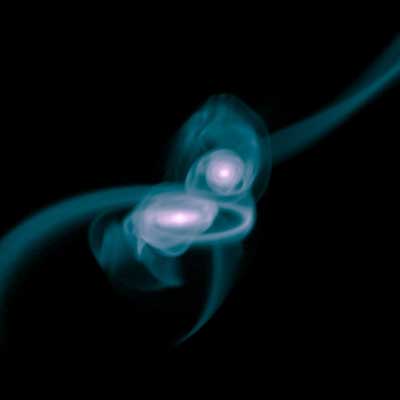Research by an astrophysicist from the University of Nottingham provides the first observational evidence of the way massive galaxies form in our universe. The results of the research are far-reaching and are used by astronomers to study apparently unrelated processes, such as the formation of black holes and the process of the formation of the stars of the universe

The study, conducted by Dr. Christopher G. Conselis, from the university's School of Physics and Astronomy, and published in the February 20 issue of the Astrophysical Journal, uses the Hubble Space Telescope's deepest images to study young galaxies that are 2 billion years old. His team found that most of the massive galaxies in the early universe underwent fascinating multiple mergers.
These mergers lead to the formation of new stars from gas cloud collisions, and apparently feed and expand the black hole clusters lurking at the centers of all galaxies.
The work helps definitively confirm what scientists have hoped to confirm for a long time - massive galaxies form when small galaxies merge together - an important and so far unproven prediction of the central cosmological standard prediction model.
"The results show us that the most massive galaxies we see in the universe today, which are passive and old, once experienced rapid collisions and mergers with each other, which, it turns out, is how galaxies form," says Dr. Konselis.
While the distant galaxies have been studied for more than a decade, until now the question of how they formed into the form we see them today has remained a mystery.
Young galaxies have low masses and astronomers have long grappled with the question of how these systems formed into the massive galaxies found in the local universe. Conselis' results demonstrate that a typical massive galaxy has undergone 4 to 5 mergers with other galaxies to transform from a young, low-mass star system into a giant galaxy.
These mergers are rare nowadays, while today only a percentage of galaxies merge, 10 billion years ago, almost all massive galaxies underwent mergers. An analysis technique developed by Conselis over more than 10 years used the most distant deep space images ever taken to confirm his discoveries.
The results also show that massive galaxies did not form rapidly, in the few million years after the Big Bang, nor did they form gradually over a long period of time. In the surprising findings, almost all of the merger activities occurred from a period shortly after the birth of the universe to about 6 billion years ago.
Dr. Konselis adds: "Perhaps the most amazing thing about these results is that the formation of massive galaxies is largely over when the universe is half its current age. This means that all the merging activities were somehow reduced by an unknown process."
The research may even hold clues about the formation of our galaxy. The Milky Way contains spiral arms, which scientists do not think were formed by a merger process. On the other hand, in the center of our galaxy there is a region of a spherical star array called a bulge - a high density region characterized by many old stars and a massive black hole - which apparently formed as a result of mergers.
The research could help astronomers see into the future of the Milky Way - one possibility is that our galaxy itself will merge with Andromeda, our largest neighboring galaxy, about a billion years from now. The merger will destroy the spiral disk that surrounds the center of the galaxy and will significantly change the appearance of our galaxy, as well as the position of the stars that we see in the sky.
